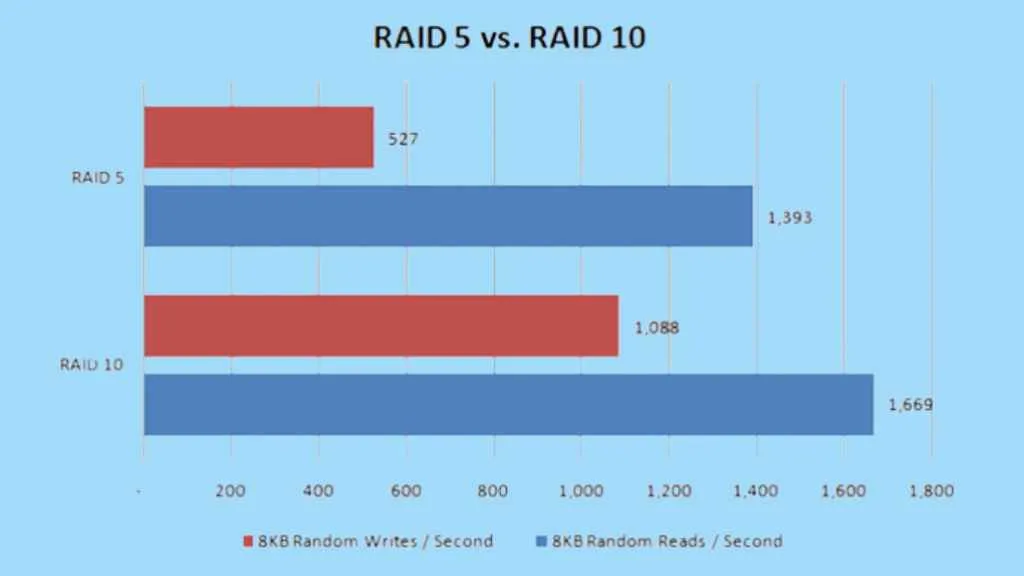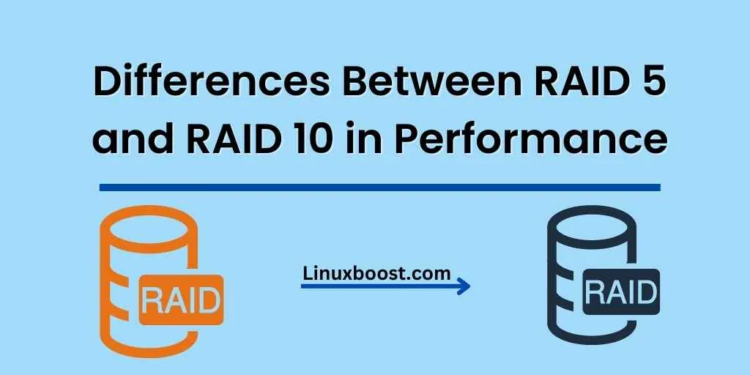When it comes to data storage and protection, RAID (Redundant Array of Independent Disks) configurations play a significant role. They help to improve the performance, reliability, and availability of your data. In this article, we’ll dive into the key differences between RAID 5 and RAID 10 in Performance and explore their performance implications.
RAID 5: Overview and Benefits
RAID 5 is a widely-used configuration that employs block-level striping with distributed parity. It requires a minimum of three disks and provides redundancy by distributing the parity data across all the disks in the array.
Benefits of RAID 5:
- Data redundancy: RAID 5 offers fault tolerance by providing redundancy with minimal disk space overhead.
- Good read performance: Since the data is striped across multiple disks, RAID 5 offers improved read performance.
- Cost-effective: RAID 5 requires fewer disks than RAID 10 for the same storage capacity, making it more cost-effective.
However, RAID 5 has some drawbacks, such as slower write performance and longer rebuild times if a disk fails.
RAID 10: Overview and Benefits
RAID 10, also known as RAID 1+0, is a combination of RAID 1 (mirroring) and RAID 0 (striping). It requires a minimum of four disks and provides both redundancy and high performance.
Benefits of RAID 10:
- High data redundancy: RAID 10 offers a high level of data redundancy, as each disk in the array has a mirror disk.
- Excellent read and write performance: RAID 10 offers fast read and write performance due to its combined striping and mirroring.
- Faster rebuild times: In the event of a disk failure, RAID 10 can rebuild the affected data more quickly than RAID 5.
On the downside, RAID 10 is more expensive due to the additional disks required for mirroring.
Performance Comparison
When comparing RAID 5 and RAID 10, it’s essential to consider their performance in different scenarios:
- Read performance: Both RAID 5 and RAID 10 offer good read performance. However, RAID 10 has a slight edge, as it can read data from multiple disks simultaneously.
- Write performance: RAID 10 outperforms RAID 5 in write performance, as RAID 5 has to calculate parity data for every write operation, which can slow down the process.
- Rebuild times: RAID 10 has faster rebuild times compared to RAID 5, as it only needs to copy data from the mirror disk, whereas RAID 5 has to recalculate the parity data.

To set up RAID configurations on different Linux systems, you can follow these guides:
- How to create RAID 1 in Ubuntu
- How to install mdadm on Rocky Linux
- How to create RAID 10 on openSUSE
- How to create RAID 5 on openSUSE
RAID 5 vs RAID 10: Which One to Choose?
Choosing between RAID 5 and RAID 10 depends on your specific needs and budget. Here are some factors to consider when making your decision:
- Budget: If you have a limited budget, RAID 5 might be a more cost-effective choice, as it requires fewer disks for the same storage capacity. However, keep in mind that RAID 10 offers better performance and reliability, which could be worth the extra investment.
- Performance requirements: If your system requires high read and write performance, RAID 10 is the better choice. RAID 5 has slower write performance due to the need for parity calculations, which can impact the overall performance of your system.
- Data redundancy and fault tolerance: Both RAID 5 and RAID 10 provide data redundancy, but RAID 10 offers a higher level of fault tolerance. If your system requires maximum data protection, RAID 10 is the preferred option.
- Rebuild times: In the event of a disk failure, RAID 10 rebuilds faster than RAID 5. If minimizing downtime and ensuring quick recovery is a priority, RAID 10 is the better choice.
Conclusion
Both RAID 5 and RAID 10 have their advantages and disadvantages. RAID 5 is a more cost-effective solution that offers good read performance and data redundancy with minimal disk overhead. However, it has slower write performance and longer rebuild times compared to RAID 10.
RAID 10, on the other hand, provides an excellent read and write performance, high data redundancy, and faster rebuild times. It’s more expensive due to the additional disks required for mirroring but offers better overall performance and reliability.
When choosing between RAID 5 and RAID 10, carefully consider your budget, performance requirements, and data protection needs. By weighing these factors, you’ll be able to make an informed decision that best suits your specific situation.
For more information on setting up RAID configurations and managing your Linux systems, explore these helpful resources:





